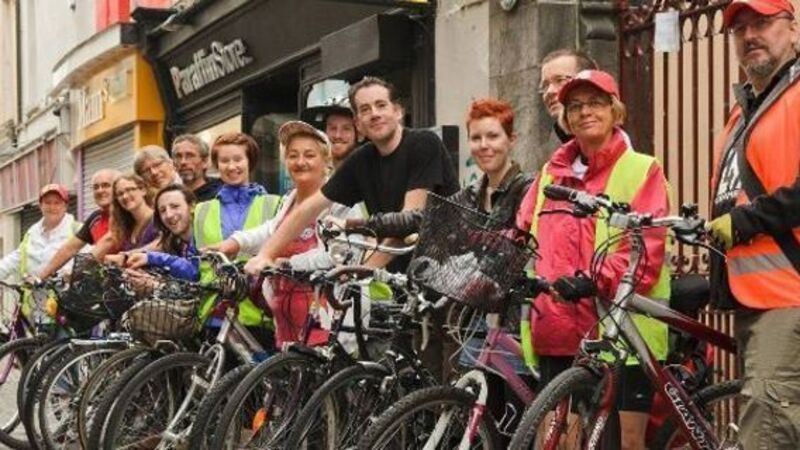Cyclists are riding high for the Cork Cycling Festival

Cycling offers freedom from the schedules of buses and trains. It cuts out parking fees and slow-moving traffic, and navigating the city on a bike is good exercise.
The freedom of cycling — roaming the city at a casual pace, or dashing across town to an appointment — is invaluable. For the past seven years, the Cork Cycling Festival has shared this fabulously simple fact.
This year, the festival includes a cycle tour to a wooded waterfall. The tour is led by Darren McAdam O’Connell, an advocate of cycling in the city. The route heads west, out along banks of the Lee river, then switches to country roads, before linking up with the Ballincollig Regional Park, via the old Gun Powder Mills.
“The cycle is about 30km long, but it doesn’t feel like that, because we stop every four or five kilometres. We will take it slow and take the whole day, so it will feel no more taxing than a cycle around the city,” Darren said. “Most people don’t realise how big the park and woods at Ballincollig is. It’s pretty empty most of the time.”
The route follows the River Lee west, past the old graveyard at Inniscarra, site of an historical monastery founded by St Finbarr on his way from Gougane Barra to Cork in the seventh century.
Are you ready to explore the skies ... on your bike? Make sure to come along on Friday (25th July) for a cycle... http://t.co/fCFaBqp3V5
— CorkCyclingFestival (@corkcyclingfest) July 16, 2014
The route continues up through the Lee Valley, through one of the oldest native woodlands in the country, which is one of the “great wildernesses of Ireland”, said Darren.
“It links up with the Gearagh at its western end,” he said. “Then, we will climb up above the dam, stop to take in the views down into the lake at Inniscarra, and, after that, head straight to link up with the Dripsey River, passing Dripsey Castle along the way.”
Dripsey Castle was built by Cormac McCarthy, one of Ireland’s chieftains, who also built Blarney Castle. “Dripsey is fully intact and is still used as a residence and the grounds contain a beautiful lake,” Darren said. “After that, we move on to an incredibly quiet road, where we once flew a kite it’s so quiet. You could go half an hour without a car passing.”
From there, it’s onwards towards Coachford, to one of Cork’s “best-kept secrets”, the Mullinhassig Waterfall, hidden in a Coillte owned-woodland north-west of Coachford village. The pool is deep enough for diving. Darren swims there all year round. “It’s the best place ever for a swim. There’s a deep pool and the current pushes you into the shallow water, so it’s totally safe. People dive off the rocks from about 15m up and it’s so deep it is totally safe do that,” he said.
The swim is not compulsory and cyclists are encouraged to bring goodies to share at the communal picnic. “I’ve done this cycle tour many times before and people love it. It won’t be rushed, there are plenty of stops, chats and stories shared, plenty of history to learn along the way,” Darren said.
Darren said of Cork City’s changing cycle culture: “Things have changed a lot. Cycling has become incredibly fashionable, it’s what everyone wants to be seen to be doing now. There’s a big difference in the attitude toward cyclists on the roads now, too. There was a lot more hostility on the roads five or ten years ago. You get a lot more smiles on your bike, these days,” he said.
Cork Cycling Festival chairwoman, Sarah Thelen, says cycling is the most efficient way to get around town. She moved from her native Ohio to Dublin, and then to Cork, with her Irish boyfriend three years ago and joined the cycle festival, as a volunteer, to make friends.
“Cork City, on the flat, is so compact. It took us 15 minutes to get through the Munster final match traffic, from Blackrock to Sunday’s Well, last weekend. I live up on Sunday’s Well, so I have to contend with the hills, but most of the hills, once you are passed them, you can get anywhere,” she said.
Sarah, a history teacher at University College Cork, said the relationship between motorists and cyclists will become more harmonious. “There are drivers that aren’t used to cyclists using the road as much, but that comes with time, as people begin to mix their transit options,” she said.
The 2013 cycling festival theme is ‘Shrink the City’, in celebration of the new contra-flow cycle lanes. Festival HQ is at the Berwick fountain, on the Grand Parade.
Cork County Cycling Club leisure spin (a 30-50km ride) for the ‘sportier’ cyclist. 1pm-4pm: Bling Your Bike.
Nervous on a bike? Learn some confidence-building skills. 1pm-5pm: To Town on My Bike — a city cycle along the new contra-flow lanes.
A maritime tour to the National Maritime College at Ringaskiddy. 1pm: A lunch-time cycle along the Curraheen Greenway. 7-9pm: Cork Past and Present — uncover the history of Cork’s streets and signs with author Tom Spalding.
A cycle tour to Blarney. 1pm: Get to know the cycle tracks from the city to CIT. 6pm: Cycle Cinema.
Waterfall Touring Cycle. 1pm: Rothspraiocht II — explore Cork as Gaeilge.
Homegrown and handmade — a cycle through Cork agricultural and food history.
A cycle tour to Crosshaven. 7pm: An Óige Cycle.
Cobh Touring Cycle to visit the town’s farmer’s market. 1pm: Picnic at the Pond. 6pm: A Lane of Our Own — getting to know Cork’s bike lanes. 10pm: Ride the Skies — Join cyclists and astronomers for a cycle under the night sky.
Grab the high nelly and dust off your tweeds for the Vintage Velo run. 2pm: Family Picnic Cycle.
World War I Cork — mark the 100th anniversary of the First World War.
Wrap party, BBQ and bike portraits.











